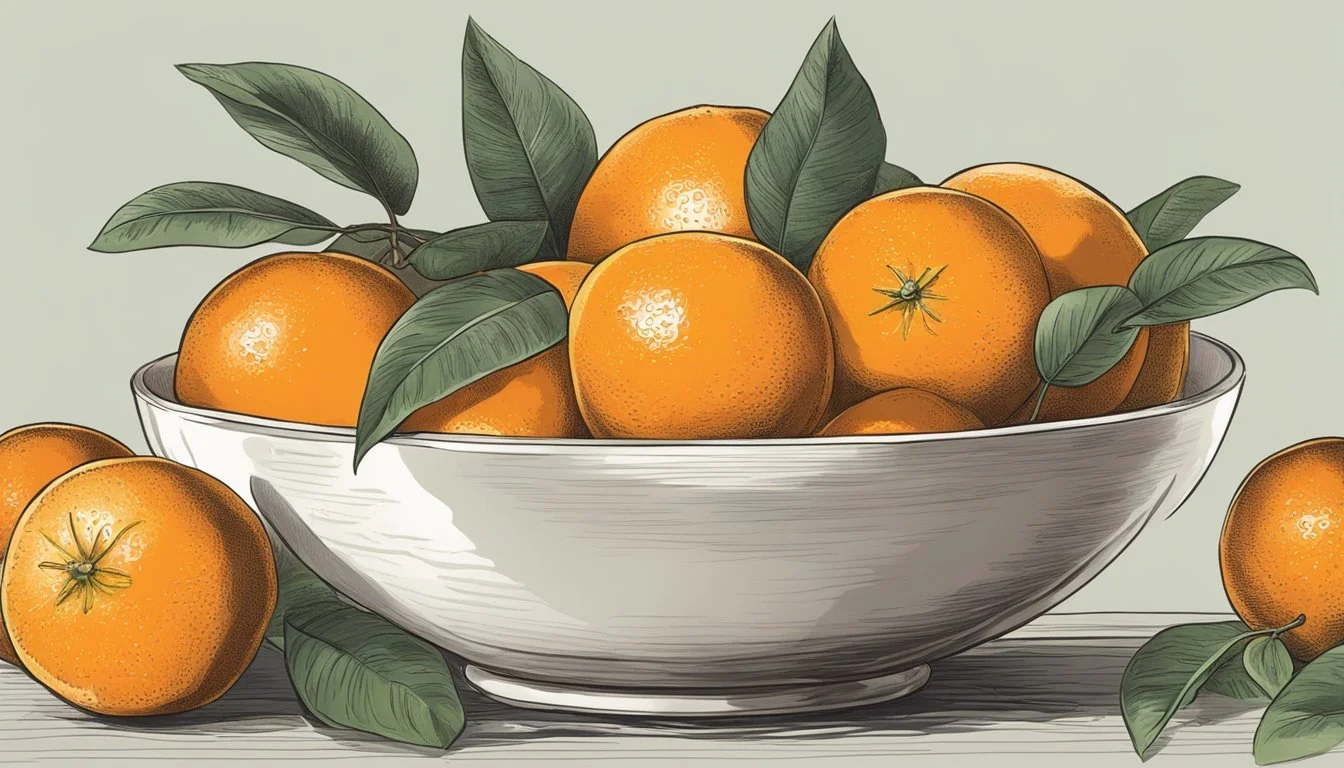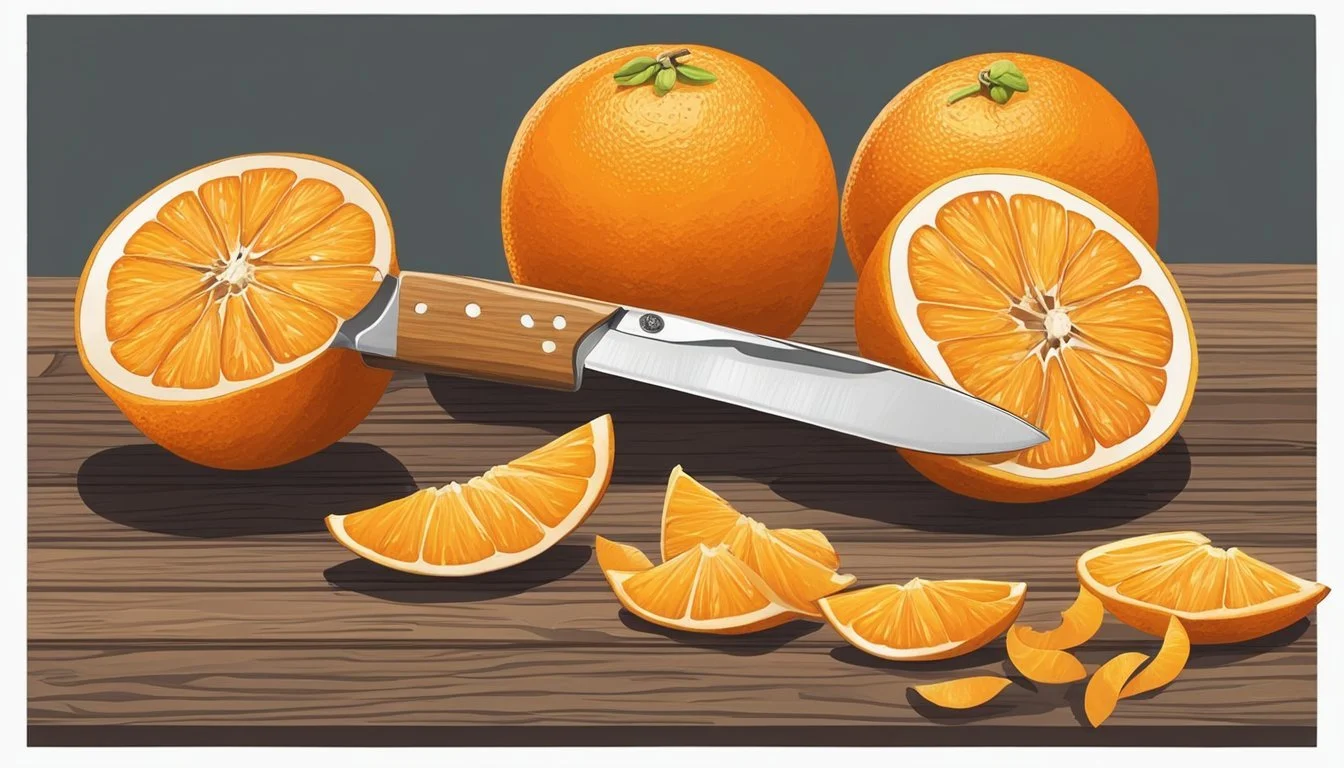Do Oranges Spoil?
Understanding Their Shelf Life and Storage Options
Oranges, like many fruits, do spoil over time. Whole oranges typically last about 10 to 14 days at room temperature and up to a month when stored in the refrigerator. Signs of spoilage include changes in texture, such as becoming mushy or slimy, and the appearance of mold, brown spots, or a foul odor.
Proper storage can extend the freshness of oranges. Refrigerating them significantly prolongs their shelf life, while leaving them at room temperature limits how long they remain good to eat. Observing the orange for any changes can prevent the consumption of spoiled fruit, which loses its flavor and can pose health risks.
For those who find themselves with a surplus of oranges nearing the end of their freshness, turning them into orange marmalade is a delicious option. By boiling them with sugar and other ingredients, one can preserve the oranges and enjoy their flavor for months to come.
The Basics of Oranges
Oranges are a popular citrus fruit known for their vibrant flavor and high nutritional value. Different types are suited for various uses, and selecting the right ones at the grocery store ensures optimal freshness and taste.
Types of Oranges
There are several types of oranges, with navel oranges and valencia oranges being the most common varieties. Navel oranges are well-known for their easy-to-peel skin and seedless nature, making them a convenient choice for snacking. They have a rich, sweet flavor and are available primarily in the winter and spring.
Valencia oranges, on the other hand, are famous for their high juice content. These oranges are typically harvested in the summer and are ideal for fresh-squeezed orange juice. They contain some seeds and are slightly more challenging to peel compared to navel oranges.
Other varieties include blood oranges, which have red flesh and a distinct raspberry-like taste, and seville oranges, used mainly for marmalade due to their tartness.
Nutritional Value
Oranges are packed with vital nutrients. They are an excellent source of vitamin C, providing more than 100% of the daily recommended intake in a single medium-sized orange. This vitamin is known for its immune-boosting properties and role in skin health.
Additionally, oranges contain antioxidants such as flavonoids, which help combat oxidative stress and inflammation in the body. They are low in calories, with one medium orange containing approximately 60 calories, and also provide dietary fiber, aiding in digestion.
The fruit also offers smaller amounts of nutrients like vitamin A, calcium, and potassium, contributing to overall health and well-being.
Selecting Oranges at the Grocery Store
Choosing quality oranges at the grocery store ensures better taste and a longer shelf life. When selecting oranges, look for those that are firm and heavy for their size, indicating juiciness. The skin should be smooth and brightly colored without any major blemishes or soft spots.
Avoid oranges with spongy or discolored areas, as these are signs of spoilage. A fresh orange will also have a pleasant, citrus fragrance. For navel oranges, check the navel area to ensure it's not too soft or moldy. For valencia oranges, a thin, shiny skin usually indicates juiciness.
Proper selection helps maintain the freshness and quality of the oranges, whether they are intended for eating fresh or juicing.
Understanding Orange Spoilage
Oranges, like any perishable fruit, can spoil due to various factors. Recognizing signs of spoilage and understanding the conditions that lead to it are key for maintaining their freshness and ensuring food safety.
Signs of Spoilage
Several indicators can help identify spoiled oranges. Discoloration is a primary sign, with affected areas often turning dull or brownish. Mold growth, particularly the green fuzzy kind, is another clear indicator. Smell also plays a role; off or sour odors suggest spoilage. Moreover, changes in texture, such as mushy or soft spots, can indicate decay. Lastly, a musty or unpleasant odor when the orange is cut open is a sign that it has gone bad.
Factors Contributing to Spoilage
The spoilage of oranges is influenced by several factors. Temperature is critical; while refrigeration can extend shelf life, it must be managed properly. High humidity levels create a conducive environment for mold. Poor airflow around stored oranges can lead to condensation, which promotes spoilage. Inadequate storage practices, such as leaving bruised oranges unsegregated, can accelerate decay. Properly storing and periodically inspecting oranges can help mitigate these risks.
Food Safety Concerns
Spoiled oranges can pose various food safety concerns. Consuming moldy or decayed oranges may lead to food poisoning. Penicillium digitatum, the mold responsible for green fuzz, can produce mycotoxins harmful to health. It's imperative to discard spoiled oranges to prevent contamination of nearby produce. Safety practices include washing hands after handling spoiled fruit and ensuring all storage areas are clean and dry. By observing these safety measures, the risk associated with consuming spoiled oranges can be minimized.
Storing Oranges to Maximize Freshness
To keep oranges fresh for the longest time possible, the temperature and environment in which they are stored make a significant difference. The following strategies will help maintain their quality and extend their shelf life.
Room Temperature Storage
Storing oranges at room temperature is convenient but not ideal for long-term freshness. Oranges kept on the countertop or in a pantry typically last up to a week.
Make sure the oranges are spread out and not stacked to prevent bruising. Avoid placing them near heat sources or direct sunlight. Exposure to heat and light accelerates spoilage and reduces shelf life.
Refrigeration Techniques
Refrigeration significantly extends the freshness of oranges. Place them in the crisper drawer for the best results. The colder temperature and controlled humidity slow down spoilage.
Whole oranges can last up to a month when stored in the fridge. For cut or sliced oranges, use an airtight container to limit exposure to air. This helps maintain moisture and prevents them from becoming dry and tasteless quickly.
Extending Freshness with Freezing
Freezing oranges is another effective method to maximize their shelf life. Whole oranges can be stored in the freezer for up to 12 months. Ensure they’re placed in freezer-safe bags and labeled with the date of freezing.
For convenience, oranges can also be peeled, segmented, and pre-frozen on a baking sheet before transferring them to a freezer bag. Thawing should be done in the refrigerator or at room temperature before consumption.
Using these storage methods will help keep oranges fresh and flavorful, whether stored in the pantry, fridge, or freezer.
Assessing and Maintaining Quality
Ensuring the quality of oranges involves knowing how to assess their freshness and utilizing them effectively before they spoil. Proper storage techniques can extend their shelf life significantly.
Checking for Freshness
To determine if an orange is fresh, examine its skin. Fresh oranges have firm, smooth skin with a vibrant color. Soft spots, wrinkles, or dullness can indicate spoilage. Smell plays a crucial role; a sweet, citrusy fragrance is a good sign, while an off smell signals decay. Conduct a taste test for the final check. Fresh oranges should taste sweet and slightly tangy. Sour or fermented flavors suggest that the fruit has gone bad.
Utilizing Overripe Oranges
Overripe oranges can still be useful in various recipes. Instead of discarding them, consider making orange juice, smoothies, or orange marmalade. Juicing overripe oranges can yield excellent results due to their high juice content. Blending them into smoothies can mask any slight off-flavors while providing a nutritious boost. Creating marmalade allows you to preserve their flavor for a longer period.
Preventive Measures
Proper storage techniques are key to maintaining the quality of oranges. Whole oranges last about 10 to 14 days at room temperature but can stay fresh for 21 days to a month in the refrigerator. Keep cut oranges and fresh orange juice in airtight containers, like plastic wrap or zip-top bags, to prevent moisture loss and contamination. Storing them correctly reduces the chances of spoilage, ensuring you enjoy fresh, tasty oranges for an extended period.
Lifespan of Oranges
Oranges have a variable lifespan depending on their storage conditions. Factors such as temperature, humidity, and how the orange is stored can significantly affect its longevity.
Shelf Life Variations
Room Temperature: Whole oranges last about 1-2 weeks at room temperature. Proper ventilation and avoiding direct sunlight can help maintain their freshness.
Refrigerated Oranges: In the fridge, whole oranges typically have a shelf life of 2-4 weeks. Cut oranges, conversely, last only 3-4 days. Refrigeration slows down the ripening process, preserving the fruit for a longer duration.
Freezing: Freezing whole oranges, when done correctly to prevent freezer burn, extends their lifespan up to 12 months. Proper packaging is crucial to avoid loss of texture and flavor.
Determining Orange Longevity
Ripeness Indicators: The longevity of an orange can often be determined by its ripeness at the time of purchase. Oranges with firm, smooth peels tend to last longer than those with shriveled or soft spots.
Signs of Spoilage: Spoiled oranges often exhibit shriveled peels, soft spots, and mold. Texture changes are also a clear indicator; firmness indicates freshness, while softness suggests spoilage.
Geographical Factors: Oranges from regions like California, known for high-quality fruit, often have a longer shelf life due to better initial ripeness and handling practices.
Storage Practices: Proper storage, including separating oranges from ethylene-producing fruits like apples and bananas, can also prolong their lifespan. Ensuring proper sanitation, especially after cutting, helps maintain quality and safety.
Practical Tips and Uses
Properly handling and creatively using oranges can prolong their freshness and add variety to daily life. These tips and uses will help prevent waste and ensure the best experience with this versatile fruit.
Proper Handling and Preparation
To extend the shelf life of oranges, storage is crucial. Oranges kept in a fruit bowl at room temperature generally last 10 to 14 days. For longer shelf life, refrigeration is recommended as it can keep them fresh for up to four weeks.
Refrigeration is key to maintaining firmness and reducing weight loss. However, it's vital to inspect for mold growth and any off smells regularly. Storing them in a breathable bag can also help prevent spoiling.
When preparing oranges, wash them thoroughly. Peeling and slicing should be done on a clean surface to avoid contamination. If you're baking, use a baking sheet lined with parchment to keep juices from sticking.
Creative Uses for Oranges
Oranges can be incorporated into various culinary and household applications. One creative idea is to make a fragrant pomander: puncture an orange with cloves and bake on a low setting until it hardens. Hang them in closets or bathrooms for a natural air freshener.
In the kitchen, blend oranges into a smoothie to add natural sweetness. They can also be used for baking—think orange marmalade as a spread or ingredient. For a refreshing twist, orange slices can be added to salads.
These imaginative uses not only reduce waste but also enhance culinary experiences. Oranges continue to prove their versatility beyond just being a snack.






